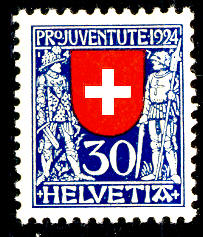- Articles Index
- Monthly Features
- General History Articles
- Ancient Near East
- Classical Europe and Mediterranean
- East Asia
- Steppes & Central Asia
- South and SE Asia
- Medieval Europe
- Medieval Iran & Islamic Middle East
- African History (-1750)
- Pre-Columbian Americas
- Early Modern Era
- 19'th Century (1789-1914)
- 20'th Century
- 21'st Century
- Total Quiz Archive
- Access Account
A Concise History of Eidgenossenschaft
By Rider, 14 June 2006; Revised
Categories: Early Modern: Political History, Medieval Europe: Political History, 20th Century: Political History, 19th Century: Political History
The oldest signs of inhabitation in Switzerland are from the Moustien culture, cave-settlements of bear hunters (in Drachenloch, 2445 meters). From the Later Paleolitchicum, there were some reindeer hunter settlements, such as Kesserloch. In the fifth millenia BC, agriculture was introduced into the north of today's Switzerland. From the fourth to the second millenia BC, people moved to the shores of the lakes. There are some remains of settlements (Robenhausen). In the 8 th centuruy BC, the level of water in the lakes rose and people were forced to leave. In those times, the territories were populated by the Celts. There have been found burial sites with weapons and nobles buried in carriages. One of those sites was La Téne.
In 58 BC Caesar fought and destroyed the Helvetic army and Rome annexed the area. The people were Romanized. In the fourth century, the areas were Christianized. In the fifth and sixth centuries, Allemans and Burgunds invaded the areas. From 496-774 the Frankish tribes settled there. The first monasteries were built around this time: Sankt Gallen in 614 and Reichenau in 724. Later on, these monasteries turned into cultural centers. On the dissolving of the Empire of Charlemagne, most of Switzerland went to the Kingdom of Germany. The west went to the Kingdom of Lotharingia. There were many different feudal properties but the Habsburgs grabbed the land for themselves in time. In 1291, three cantons: Uri, Unterwalden and Schwyz created the Forever Alliance in the defense agaonst the Habsurg family. In the Battle of Morgarten (15. 10. 1315) the Alliance crushed the Habsburg army. Luzern (1332), Zurich (1391), Zug (1352, Clareus (1352) and Bern (1353) joined the Forever Alliance. The Forever Alliance was renamed, Eidgenossenschaft. Switzerland insured its independence in battles against Austria (1386 Sempach, 1388 Näfel) Burgundy (1476 Morat, 1477 Nancy) and the Swabian Alliance (1499 Dornacht). The Peace of Basel (22 September of 1499) made Switzerland independent from the Holy Roman Empire. Fribourg and Solothunn (1481), Basel and Schaffhausen (1501) and Appenzell (1513) joned the Confederation. In 1513, the Confederation had 13 cantons (plus 10 additional territories with smaller rights). It remained so until 1798. From time to time, the contradiction between city-cantons and forest-cantons arose. Economic development often slowed down because Swiss mercenaries travelled to European countries (Reislaufen). The contradiction between cities and wilder areas became obvious during the Reformation. In Zurich, the Reformation was led by Ulrich Zwingli; in Geneva Jean Calvin. In the Battle of Kappel (1531) the canton-army destroyed the Army of Zurich. Zwingli died in battle. In 1549 the men of Zwingli joined the followers of Calvin. From 1524 to 1525 there were many different rebellions across the state. In the Thirty Years’ War, Switzerland remained neutral and with the Treaty of Vestfaal (1649) Switzerland was officially recognized. The fights between Protestants and Catholics continued. In 1712, the Protestant cantons started to dominate after a slight victory. In 1798 the French Army conquered Switzerland and declared it a vasall of France with the name of the Republic of Helvetica. The wilder areas continued to resist Napoleon Bonaparte I, with the Act of Mediation (1802) Switzerland changed into a federation (19 cantons altogether). Congress of Vienna ackowledged Swiss independence and declared it forever neutral. With the Confederate Deal (07 August 1815) Switzerland was transformed into a Federation with 22 cantons. With the French July Revolution in 1830, 12 Cantons declared a liberal constitution. To counter that, 7 Catholic and conservative cantons formed the Special Confederation (Sonderbund) (1843-1845). In the Civil War of 1847, the Sonderbund was defeated. The Constitution of 1848 turned Switzerland into a centralized state. The Constitution of 1874 strenghtened centralization. Industry started to develop in the second half of the nineteenth century. Swiss banks became known worldwide. For the refugees of WWI and WWII, Switzerland was the perfect place. Being neutral, many industrial organizations were founded there. Switzerland remained neutral throughout the entire course of the both World Wars. Switzerland joined the United Nations in 1920 and Geneva became a center for that organization. Women got voting rights in 1971. Important dates: · 1460: Basel university was founded. · 1537: Lausanne Academy was founded · 1738: first Swiss newspaper “Feuille d’Avis de Neuchatél”
|


